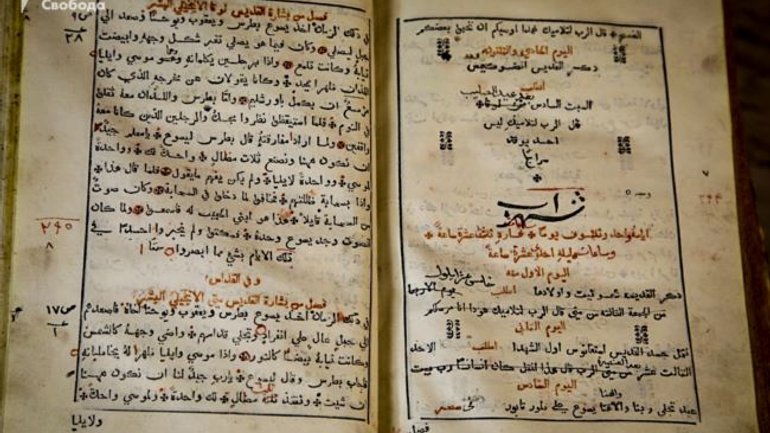Ivan Mazepa’s unique Gospel in Arabic found in Lebanon

The valuable gospel was printed in 1708 in Aleppo and discovered in late 2019 during a visit to the Balamand monastery near Tripoli in Lebanon. This is reported by Radio Liberty.
Hetman of the Cossack state, Left-Bank and Dnieper Ukraine Ivan Mazepa wanted the independence of the Ukrainian Orthodox Church from Moscow and for this purpose tried to enlist the support of Christians in the Arab world. The valuable gospel, according to the Hetman, was to become a symbol of strengthening the Union with the Orthodox Church of Antioch.

The relations of the churches acquired the most significant significance during the time of Hetman Ivan Mazepa. Since the Ukrainian Orthodox Church at that time was under the leadership of the Moscow Patriarchate, Mazepa's strategic line was aimed at strengthening the Ukrainian Church as the state Church of the Hetmanate.
Ivan Mazepa was one of those patrons who provided real help to Orthodox Christians in the Arab world. The result of the Hetman's generous support was the publication in January 1708 in Aleppo at the expense of Mazepa, but in a printing house that was given to the Arab Orthodox Christians by the ruler of Wallachia, Brynkovyanu, - the Gospel in Arabic.
For the publication of the gospel, which was a gift from Mazepa to the Church of Antioch, the Hetman provided 3,000 gold pieces, and before that, allocated another 3,000 to support Antioch.
Scientists have known about the existence of the "Gospel" for a long time.
In 1942, historian Mykolai Andrusyak wrote in an essay "Hetman Ivan Mazepa as a cultural figure" published in Prague: "copies of the Arabic gospel, published at the expense of Mazepa in Aleppo in 1708 for the liturgical use of Orthodox Syrians, have Survived to this day."
In 1993, the scientific expedition of the NASU in search of the "gospel" went on the route Baturin-Kyiev-Bendery-Varnytsia-Yassy-Galats. In Bucharest, which was the last destination of the expedition, a copy of the Arabian "Gospel" was discovered.
In 2009, the Ukrainian researcher and diplomat Teofil Rendiuk made a high-quality photocopy of the entire text of Ivan Mazepa's "Gospel" in Arabic in the library of the Romanian Academy and brought its electronic version to Ukraine.

It also turned out that in Aleppo in 1706-1708, several editions of the "gospel" were printed, and with the support of a number of sponsors, among them the already mentioned Constantin Brâncoveanu and Ivan Mazepa.
A few years ago, after heading a diplomatic mission to deepen Ukraine-Middle East relations, Igor Ostash, Ambassador extraordinary and Plenipotentiary of Ukraine to Lebanon and a scholar, began searching for an Arabic copy of the Gospel in Lebanon, which also belongs to the territory of the Patriarchate of Antioch.
And so, at the end of 2019 – the year when the Orthodox Church of Ukraine (OCU) received the Tomos and became independent from Moscow – during a visit to the Balamand Monastery, a rare find was discovered in a special center for the preservation of old printed books.
"During our search, we found several Gospels and, unfortunately, all of them are incomplete. Time has done its work. It should be understood that, unlike museum copies, these Gospels were still used by the clergy until recently. And this is what makes their value. This means that Mazepa's mission has succeeded. Even after 300 years, we see the consequences of his noble cause, " said Ambassador Igor Ostash.
"What we can say for sure today," he continues, " is that the gospel of Ivan Mazeppa was printed by Abdallah Zaher, who is considered the first printer here in Lebanon. His figure is another link between Lebanon and Ukraine. In the different Gospels is not enough a different number of pages, but mainly more losses among the first and last pages. We realized that it is almost impossible to find two identical Bibles. The circulation was printed for about a year and during this time new letters and font elements were often produced. But we do not stop in our search. We planned to visit another monastery, about some of the things we can't talk right now, given the current political situation. One thing I can say for sure: the publication of the Gospel will be carried out this year. As for the text, today we are conducting textual and graphic research. They will be published along with the Bible."
In parallel with the research, we started shooting a documentary about the gospel of Mazepa, where the author, Igor Ostash, and the Director, Stanislav Lytvynov, want to tell the fascinating journey of this publication through the centuries, as well as about the unique figure of Abdallah Zaher, the printer of the gospel, as another thread of historical connection between the Middle East, now Syria, Lebanon and Ukraine.









